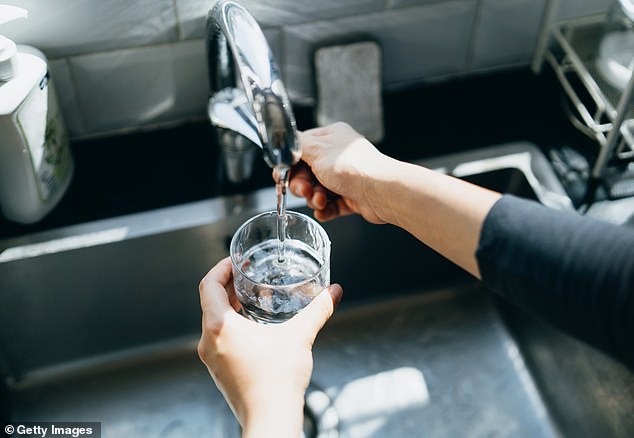A potentially cancerous chemical has been discovered in the drinking water consumed by tens of millions of Americans.
Known as chloronitramide anion, the compound is released when a popular disinfectant called chloramine (a mixture of chlorine and ammonia) breaks down naturally.
About one-third of U.S. households receive chloramine-treated water, equivalent to about 113 million people.
It’s unclear what effect the new compound has on humans, but researchers said its similarity to other toxic chemicals “warrants further study to assess its public health risk.”
Julian Fairey, lead author of the study and professor at the University of Arkansas, said, “It’s well known that when we disinfect drinking water, it creates some toxicity.” Chronic toxicity, really.
‘A certain number of people can get cancer from drinking water over several decades. But we have not identified what chemicals are causing that toxicity.
“One of the main goals of our work is to identify these chemicals and the reaction pathways through which they are formed.”
A potentially cancerous chemical has been discovered in the drinking water consumed by tens of millions of Americans.
If people are concerned about exposure to the chloronitramide anion, Fairey told DailyMail.com that “a household filter (i.e. a Brita filter or refrigerator filter) will help remove it, although we don’t know for sure.”
But he warns that boiling drinking water could actually increase the concentration of the chloronitramide anion and that it is “not alive like the bacteria that could be killed by boiling.”
Water companies typically use a series of water treatment steps, with filtration and disinfection being the final processes before the water is stored in tanks or reservoirs.
Common types of chemical disinfectants include chlorine, chloramine, or chlorine dioxide.
Chloramine is preferred in many parts of the world for its properties.
It is less volatile than chlorine, meaning it stays in the water longer and provides longer-lasting protection.
It also has a less distinctive taste and odor than chlorine, which can have a bleach-like odor and taste in water.
A disadvantage of chloramine-treated water is that it has a more corrosive effect on pipes and plumbing.
According to American Water, chloramine has been used to treat water in many states for decades and Denver, Colorado, for example, has used chloramines since 1917.
Other countries with chloraminated drinking water include Scotland, Australia and Canada.
Chloramine is added to water by introducing ammonia into water that already contains chlorine, causing a chemical reaction between the two substances to form chloramine; This process is known as “chloramination.”
The U.S. Environmental Protection Agency (EPA) says water with chloramine levels of up to 4 milligrams per liter is safe for drinking, cooking, bathing, and other household uses.
Fairey noted that researchers have known about the new compound for decades, but have not been able to identify it.
He himself began trying to unravel the mystery 10 years ago.
“It’s a very stable chemical with a low molecular weight,” Fairey said.
‘It is a very difficult chemical to find. “The hardest part was identifying it and proving it was the structure we said it was.”
In future work, academics and regulatory agencies, such as the U.S. Environmental Protection Agency, will evaluate whether the chloronitramide anion will be linked to any cancers or have other adverse health risks.
The EPA has not yet commented on the recent findings.
“Even if it’s not toxic,” Fairey explained, “finding it can help us understand the pathways by which other compounds, including toxins, are formed.” “If we know how something forms, we can potentially control it.”

In future work, academics and regulatory agencies will evaluate whether the chloronitramide anion will be linked to any cancer or have other adverse health risks.
A study published this fall also delved into the toxicity of drinking water.
Researchers at SimpleLab in California analyzed drinking water from the San Francisco Bay area, including 100 samples of bottled water, 603 samples of tap water, and 111 samples of treated household water (water that was filtered at home using a Brita filter ).
These included bottles labeled as spring, artesian, mineral, well and purified water and were purchased in July 2022. They did not specify which brands of water were purchased, but said they were representative of the options in California.
The homes tested were those that purchased a SimpleLab water quality testing kit.
They analyzed it for contaminants and the results of the study were published in the journal. The Public Library of Water Sciences.
The team found that about 53 percent of bottled water, 61 percent of home-treated tap water and 98 percent of untreated tap water tested were linked to at least one health problem.
The most common contaminant they found were chlorine byproducts used to disinfect water, called trihalomethanes. These were found in all three water sources, but were highest in tap water.
Consumption of trihalomethanes in large quantities has been linked to developmental delays, reproductive effects, liver damage, and an increased risk of cancer.
Other contaminants the researchers found in the water tested included heavy metals such as lead.
Lead often enters the water supply through old pipes or infrastructure. It was detected in 30 percent of home-treated tap water and 51 percent of tap water samples.
Frequent exposure to lead can cause neurological, developmental, learning and behavioral problems, most commonly in children.
Climate change, aging infrastructure and pollution contribute to people’s current struggles to obtain pristine drinking water, but this has primarily been studied in tap water.
In response, Americans have turned to bottled water. Total quantities used have increased from 28 gallons per person per year in 2010 to 45 gallons per person per year in 2020.
If you are served by a public water system, the CDC notes that it is possible to find annual water quality reports online that show the type of disinfectant used, the levels present, and the disinfection byproducts if the levels were not within a safe range.


